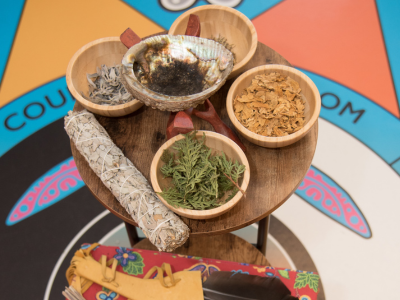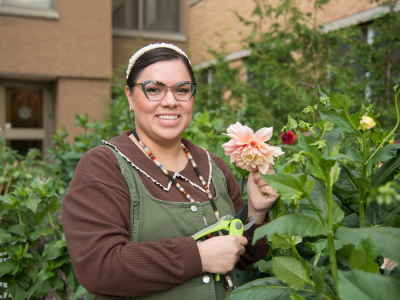
Victoria Hospital’s Indigenous Healing Garden
June 23, 2025
Tucked into the grounds of Victoria Hospital, the Indigenous Healing Garden is more than just a quiet green space – it is a place of ceremony, reflection, and connection to the land. Rooted in Indigenous knowledge and healing traditions, the garden honours the strength, culture, and traditional medicines of First Nations, Inuit, Métis and Urban Indigenous (FNIMU) Peoples.
Developed in partnership with Atlohsa Family Healing Services and funded by both London Health Sciences Foundation and Children’s Health Foundation, the Healing Garden acts as an extension of LHSC’s Indigenous Healing Space, where Indigenous Peoples and settlers can connect with the natural world and give thanks to the Creator.
Through a collaborative effort between Clintar Commercial Outdoor Services, Atlohsa, and LHSC’s Indigenous Health and Facilities Management teams, the space came to life.
“Finalizing the design and working to understand the area was a collaborative effort,” says Chris Askew, Director, Facilities Management. “A lot of research was done by our department and Clintar with guidance from internal and external Indigenous community partners throughout the process of plant selection and for the placement of the Medicine Wheel. We needed to make sure everything was done properly.”
The Medicine Wheel, located in the centre of the garden, is a sacred circle representing the interconnectedness of life. The Medicine Wheel is divided into four quadrants, each corresponding to a cardinal direction North, South, East, and West. The directions each carry unique symbolism, colour associations, and spiritual attributes.
The garden, which features three of the four sacred medicines – sage, cedar, and tobacco – helps to provide a more wholistic care experience at LHSC. The four sacred medicines (which also includes sweet grass) play an integral role in ceremonies, teachings, and healing practices in Indigenous culture, each carrying unique properties and significance.

Above: The four sacred medicines available through LHSC’s Indigenous Healing Space.
“Traditional medicines are the heartbeat of our community’s health and wellness, connecting us to the wisdom of our ancestors,” says Chantel Antone, Indigenous Health Lead. “In embracing these practices within our hospital, we honour the sacred balance of body, mind, and spirit, fostering a wholistic approach to healing that respects and uplifts all people.”
LHSC’s Indigenous Health staff, with their deep understanding and respect for these traditions, harvest these medicines, ensuring their authenticity and effectiveness. Indigenous Health staff then use traditional medicines and LHSC’s Visiting Elders program when working with patients and staff to support the vision of providing wholistic care.
The Visiting Elders program is a vital initiative that connects Indigenous patients, families, and team members with Indigenous Elders, offering culturally grounded healing practices which honour the Truth and Reconciliation Commission’s Calls to Action. By offering holistic care that embraces the heart, mind, body, and spirit, and sharing teachings that enhance cultural understanding, the program plays a meaningful role in LHSC’s efforts to advance Reconciliation.
Empowering youth through traditional healing
One staff member who has embraced this approach is Nicole Yawney, Youth Indigenous Wellness Consultant at Children’s Hospital at LHSC. She often works with patients in the Healing Garden through the Youth Indigenous Wellness Program and the Land-Based Healing and Nature for Healing Initiative that has been shared across Children’s Hospital.
“Often times the first feedback I get from patients is that they want to go outside; they want to smell the fresh air. Taking them down to the Healing Garden helps to reintroduce playful, childhood experiences,” says Yawney. “It allows for the creation of moments where they can smile and laugh in a different space, and all of this helps with their ability to cope.”

Above: Nicole Yawney, Youth Indigenous Wellness Consultant, stands in the Victoria Hospital Indigenous Healing Garden
Some of the youth that access the garden are involved in dialectical behavioural therapy (DBT) at Children’s Hospital and Nicole finds that traditional Indigenous healing practices support the skills they learn in this type of therapy.
“I like to help the youth make connections between what they learn in their program and the Indigenous ways of knowing,” explains Yawney. “The Healing Garden is a place where patients feel a sense of belonging and because of that, guards come down and simple human-to-human conversations lead to more nuanced health-related conversations.”
Traditional Indigenous education is an important aspect of the work Yawney does with patients. The Healing Garden helps to supplement traditional teachings by providing the physical connection to Indigenous culture while patients are seeking treatment. It is a space for individuals to be surrounded by the traditional medicines, to touch them and create the connections that are grounded in the teachings from Elders and the community.
“We like to talk about the medicines,” says Yawney. “There is a protocol to follow before they are harvested, and they must learn about the custom of providing an offering to the Creator. Tobacco is always offered before anything is taken from the Creator. It is very important to provide something in return for what you need.”
The tobacco used in these offerings is in its dried form, meaning it has been harvested, dried, and the leaf and stem have then been separated. All four of the sacred medicines are accessible to patients and staff in the Indigenous Healing Space, reflecting LHSC’s commitment to providing a space which honours the traditional medicinal and healing practices of FNIMU Peoples.
Advancing Reconciliation through inclusive care
Though the garden was created as an extension of the Indigenous Healing Space where Indigenous staff and patients at LHSC can access traditional medicines, all are welcome. Patients, family members, and Team LHSC are encouraged to use the space and to start conversations about the wholistic care experience traditional Indigenous healing practices can provide.
At LHSC, we are deeply committed to advancing Truth and Reconciliation through meaningful action. The Indigenous Healing Garden is a reflection of our dedication to honouring Indigenous ways of knowing and healing, and to implementing Joyce’s Principle and Jordan’s Principle, which call on health systems to guarantee all Indigenous Peoples the right to equitable, culturally safe care.
“The Healing Garden and our broader Indigenous Healing Space serve as living symbols of our commitment to wholistic, inclusive care,” says Antone. “They represent a foundational step in transforming our health system to one that listens, respects, and walks alongside Indigenous Peoples in health and healing.”
To learn more about the Visiting Elders program happening every Wednesday and the other traditional healing services offered at the Indigenous Healing Space, visit LHSC’s Indigenous Health website.
